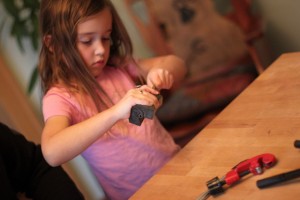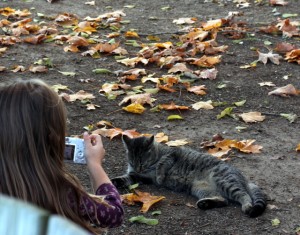 A huge segment of the toy industry makes kids cameras, plastic hardware tools, faux art supplies, and character-branded naturalist equipment. The motivation for such things might be pure, but they are often cheaply-made, useless imitations of adult tools.
I can't tell you how many 'kid' versions of tools have met their end in our donation bin. We toss the plastic screwdriver that doesn't actually work with screws, the cheapo watercolors that have no pigment, the child-friendly measuring cups that are cute but hard to use.
A huge segment of the toy industry makes kids cameras, plastic hardware tools, faux art supplies, and character-branded naturalist equipment. The motivation for such things might be pure, but they are often cheaply-made, useless imitations of adult tools.
I can't tell you how many 'kid' versions of tools have met their end in our donation bin. We toss the plastic screwdriver that doesn't actually work with screws, the cheapo watercolors that have no pigment, the child-friendly measuring cups that are cute but hard to use.
Use the Real Thing What's wrong with allowing children to use the real thing? If your child is distractable, keep your hands on the binoculars as they use them. Use the DSLR camera together or give them an outdated but still functional digital camera. Your ancient point and shoot is far superior to the kiddie version.
Buy genuine artist supplies at the craft or art store. Paints and brushes might be more expensive but they outlast and outperform the kiddie versions. While you are there, invest in some real artist paper or canvases.
Provide lightweight but real hammers and let children practice aim with the possible natural consequence of hitting their thumb. Because they are performing a real and honest task, chances are good they won't even complain about a small hurt.
 Process Not Product
Young children (and most adults) learn more from the process of an activity than enjoy the eventual product. Sure, kids have great imaginations and should pretend to fly rather than actually attempt it. But when we can give our children real experience in the process of creating something, they will feel empowered. They will gain true skills and competence that faux tools do not allow.
Process Not Product
Young children (and most adults) learn more from the process of an activity than enjoy the eventual product. Sure, kids have great imaginations and should pretend to fly rather than actually attempt it. But when we can give our children real experience in the process of creating something, they will feel empowered. They will gain true skills and competence that faux tools do not allow.
Too Young or Too Expensive? I have high expectations for my six year old because she has been handling real tools from the moment she could handle tools at all. She has used sharp knives since she was three and power tools shortly after. Her mastery of one tool is rewarded with the next.
I believe that all kids can handle real tools when they are presented with supervised experiences from a young age. Expectations for safety must be held in the highest regard. If a child cannot handle themselves, the tool should be removed without punishment but a simple "you're not ready for this right now."
Some might argue that real tools are more expensive than the kid version. While this might be true, I think of purchases as an investment over time. It is not unrealistic to think that the genuine 6" santoku knife I bought for Lil last year will travel to college with her. Same with her quality flash light, sewing kit, and binoculars. Perhaps I actually saved money by skipping over the kiddie junk.
So what if something breaks? First, naysayers might be surprised at the durability of adult tools. Lil has dropped her ancient Canon PowerShot camera dozens of times and it still functions well.
If something does fall to pieces, so be it. Adults and children make mistakes that cause glasses to break and knives to bend. I use damage incidents to talk about whether we have a budget to replace it or if we can try to fix the broken part or if we might need to be creative and do without something for awhile. These are all natural consequences to an inevitable part of living.
 It's a Tool, Not a Toy
The above phrase echoes around our house. Scissors are a tool and I expect Lil to use them safely or the privilege of using them is revoked. Matches must be consumed for a purpose - they are not play things. Use the strap to secure binoculars and cameras.
It's a Tool, Not a Toy
The above phrase echoes around our house. Scissors are a tool and I expect Lil to use them safely or the privilege of using them is revoked. Matches must be consumed for a purpose - they are not play things. Use the strap to secure binoculars and cameras.
Lil approaches projects with sincerity towards the tools she might need. She isn't afraid of fire or sharp things because she practices using them safely under supervision. She still struggles with things that her small size body can't manage, like heavy hammers. If she comes across a project that requires a tool she isn't ready to handle, we assert ourselves as keepers of her safety and assist.
Does my daughter have good awareness because of something innate or because we encourage her to explore and create using tools? It's probably a little bit of both.
Each parent knows their child and must estimate how their child will handle a certain tool. Place safety at the forefront. Set them up for success by giving them new tools when they are fed and full of focus. Allow them to make mistakes and take time away from the project.
I know that I am not alone in raising a child who uses real tools. There are preschool classrooms of children who use saws and other mature tools. Why?
Because kids want and deserve the chance to make things.
Because trusting a child to operate a tool encourages them to trust themselves.
Because we don't know who will illustrate the world with watercolors or build inspiring houses or take amazing pictures or cook incredible dishes when they are given the right tools.
